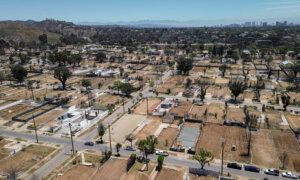According to a recent study from Go Banking Rates, a personal finance website, retirees in California need much more than $1 million saved to live comfortably.
That sum is expected to last slightly longer than 12 years, eight months in the Golden State. Only Hawaii, Massachusetts, and Washington, D.C. fared worse in terms of length of time such savings will last.
Total annual expenditures for Californians were estimated to be nearly $79,000—including groceries, utilities, and housing, among other things.
According to the study, published in May, savings of $1 million would last the longest in West Virginia—with annual expenditures of slightly less than $50,000. Such a nest egg could provide for more than 20 years of retirement.
While most costs between various states vary little, discrepancies in housing expenses were the exception.
Researchers calculated housing costs in California at slightly more than $22,000 a year, although some others, including online listing company Zillow, calculate the amount closer to $34,000.
Similar to the Go Banking Rates study, a cost-of-living analysis published in April by California’s nonpartisan Legislative Analyst’s Office found that home prices are “much more expensive” than other states across the country.
The analyst’s study concluded that mid-tier home prices in the state are more than twice the price as similar homes in other states. Additionally, prices for bottom-tier homes in California have risen in recent years, pushing average costs to about 33 percent more than mid-tier homes in the rest of the nation.
Such gaps have widened over the past decade, the analysts reported.
With home insurance prices also skyrocketing in recent years—as many insurers fled the state after wildfires led to billions of dollars in damages—monthly payments to own a home have become out of reach for many families.
Mortgage, taxes, and insurance payments for mid-tier homes “increased dramatically” and topped $5,500 monthly, an increase of 80 percent since January 2020, according to the analyst’s report.
Such is creating significant differences in renting versus buying, with the gap at levels last experienced during the housing price bubble in the mid-2000’s, the report found.
Analysts point to higher interest rates—which have climbed from about 2.7 percent for a 30-year fixed rate mortgage in January 2021 to about 7 percent in mid-2024—as contributing to the escalating housing prices.
“Furthermore, when both mortgage rates and prices increase, there is a compounding effect on monthly home payments, as borrowers have to pay higher interest costs on higher loan amounts,” analysts wrote.
Housing expenses are also outpacing wages, which is putting further pressure on retirement savings. Since January 2020, costs to own a home have jumped more than 400 percent compared to average hourly wages, according to their report.
With housing topping the list of reasons many are insecure about retirement, other expenses, according to the report including health care and general cost of living expenses are creating uncertainty, as well.
A 2021 survey by investment firm Charles Schwab found that Americans need about $1.9 million to retire comfortably, no matter where they live.
However, recent data from California’s Treasurer’s Office reveals that nearly one-third of all residents 55 or older have no retirement savings.
Some Californians expressed concern that they don’t have enough saved to ever retire comfortably, especially considering the rising cost of food and other items.
“I’m afraid I’ll have to work for the rest of my life,” Jessica Morgan, a customer service manager from Alameda County in the East Bay, told The Epoch Times. “We’re struggling to pay our bills now, and there’s no way I can put more back to live on later.”
While the U.S. Bureau of Labor Statistics estimates current inflation rates at 3.3 percent, according to the most recent consumer price index, some Californians say the sharp increase of many items is more painful than the numbers suggest.
“We shop on a budget, but some of the groceries we buy cost so much more now [than in past years] that we can’t afford to eat the same foods,” Ms. Morgan said. “And the price of gas is really hurting us.”
Another concerned Northern Californian already nearing retirement age said the thought of not bringing in steady income is unbearable.
“I don’t know what I would do if I couldn’t work,” Maria Ramirez, a grocery store employee in Santa Rosa in the North Bay, told The Epoch Times. “Everything is so expensive.”














